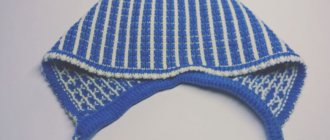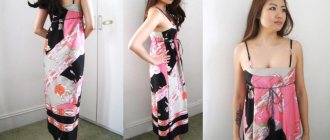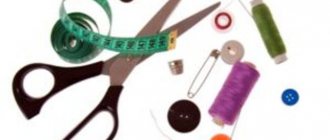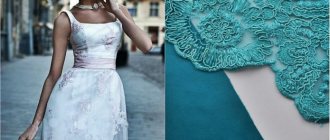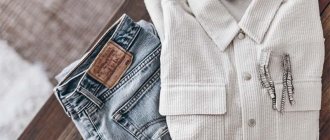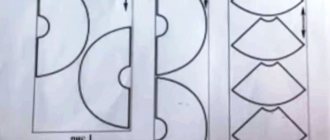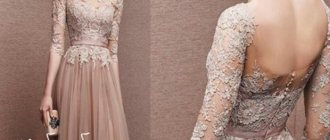On warm spring and summer days, women especially want to look beautiful and not just walk along the streets, but flutter like butterflies. A light, flowing, airy chiffon dress is what you need to feel exactly like this. In stores you can find a variety of models from this fabric, however, with minimal sewing skills, you can make it yourself.
Chiffon dress: photo
Creating a chiffon dress is very easy and simple, and you don’t need to have a lot of experience in sewing. So, first you need to take standard measurements for the dress - chest circumference, hips and waist, shoulder length, length of the future dress.
When choosing the color of a dress, you should consider where you plan to wear it - for example, a long dress made of peach-colored chiffon looks incredibly gentle and beautiful, which is perfect for a walk on a summer evening or going out.
Stage three: cutting the fabric
For self-tailoring, it is best to take simple models that do not require extensive calculations and time-consuming pattern development. The simplest models in this case are the same dress with a circle skirt and a style with a bodice without shoulders and floor length. These models are the simplest to implement.
How to sew a chiffon dress with a circle skirt? To begin, cut out a donut-shaped part from the fabric. The inner opening should be equal to the volume of the hips, and the fabric should be length to or below the knees, as intended by the style. It is this blank that will be the skirt of the product. You need several such details if the fabric is very luminous. The bodice is cut out as follows: take measurements of the hips and chest and cut out two rectangles with a width equal to half the measurement. Next, the neckline is cut out so that the head fits easily into it, the shoulders are beveled 1.5 cm to the sides and the armholes are slightly deepened.
Cutting a floor-length dress with an elasticated bodice is even easier. For this product, only two parts are needed: a skirt, slightly sloping along the side seams towards the top, and a rectangle for the bodice, equal to the chest measurement + 8-10 cm.
Pattern and description of a chiffon dress
As soon as the color and style of the dress is chosen, you need to start cutting the material; for this, a simple pattern is created. The future dress will consist of 2 parts - the 1st dress bodice, and the 2nd maxi length skirt. Taking into account the previously taken measurements, you need to make a paper pattern of the bodice, after which it is carefully transferred to the fabric.
You need to cut out 2 such parts from paper - one will be for the front, and the second will be for the back. You need to create a symmetrical pattern, and in order to get a single piece as a result, the fabric is folded in 2 layers and the pattern is placed on top of it. Then you need to cut it out and unfold it. When creating a pattern, it is worth considering that there should be a few centimeters of fabric left on the sides for seams.
It will be even easier to create a chiffon skirt for a dress. First, the required rectangular piece of fabric is prepared - it is important to ensure that its width is equal to the resulting waist volume multiplied by 3. It is this coefficient that will show the average fluffiness of the future skirt.
It is important not to forget about the lining, because chiffon is not only very light, but also translucent fabric. In almost all cases, the lining is slightly shorter than the main chiffon part, making the product look elegant and sophisticated. In this case, you can use the same chiffon or silk to match the main fabric as a lining.
The edges of the material must be machined, as they may fray. A vertical stitch is made along the wrong side of the product, which will connect the rectangle (skirt) along the edge.
To make the skirt emphasize your figure, you should use the simplest elastic band. The main thing is to measure the length of the elastic band correctly - the elastic band stretches a little at the waist and another 3 cm is added to the resulting length for an allowance.
The elastic is threaded into the belt, the width of which should be slightly larger than the elastic itself (plus 5 mm, but no more). Since chiffon is very see-through, in the upper part of the skirt the fabric must be folded in several layers and then stitched. In this case, a small section should be left unstitched, since the elastic will be pulled into the belt through it.
Next, the 2 ends of the elastic are sewn together, and it is carefully secured using a hand-made, invisible seam. Now the skirt of the future dress is completely ready.
The result is an interesting dress model consisting of a bodice and a skirt, which can be worn separately or together.
Stage two: calculating the amount of fabric
In order to calculate what piece of material is needed for a particular model, you should select the style of the product. Simple dresses with a gathered skirt at the waist are made from fabrics with ornaments along the edges of the fabric. But from fabric with a pattern all over the field, you can make completely different models, for example, a dress cut on the bias, with a multi-layered circle skirt, with a straight floor-length skirt and a high slit, and many others. All styles of chiffon dresses will look great! And, besides, such a thing will be exclusive and relatively inexpensive.
However, in order to sew a chiffon dress yourself, you should correctly determine the amount of fabric. For a circle skirt, you need to take three lengths of fabric for the bottom and a section for the bodice. What does it mean?
For example, if a skirt should be approximately 60 cm long from the waist to the knees, then for such a product you will need about 2.5 meters of chiffon (180 cm for the bottom, 70 cm for the top of the product). However, it is worth considering that this material is very luminous, and therefore the skirt will need to be made either from several layers of the same material, or with a lining of a plain non-luminous fabric.
If you plan to sew a summer dress from chiffon with a so-called coupon pattern on the bottom, then for such a product you should take fabric at the rate of 70 cm for a bodice with shoulders and a small sleeve, or 50 cm for a bodice gathered with an elastic band above the chest. For a skirt in this case, you will need two to three hip measurements, depending on the desired number of pleats at the waist.
For a short dress cut on the bias, the fabric is calculated based on the required length of the product and double footage is taken.
How to sew a dress from chiffon?
- To cut chiffon, it is recommended to use a circular knife and do it only on the backing. If it is not possible to use them, then you can place any backing under the chiffon, the main thing is that it does not slip, and to cut the fabric you can use simple tailor’s scissors.
- A paper pattern should be pinned with pins with a sharp end, since even a slight notch can completely ruin a piece of fabric. To attach pattern pieces, you can use a special adhesive spray or thin adhesive strips.
- If you use spray glue, then you need to place part of the pattern on the fabric strictly along the transverse (lobar) thread, and place a small weight in the middle. Now the edges of the pattern are treated with spray glue and left for a while for the glue to “set”, then the pattern is pressed tightly to the fabric.
- All markings and contours of the pattern pieces should not be transferred to chiffon using carbon paper or a toothed wheel, since the lines on the front part of the chiffon will begin to show through and unsightly marks from the wheel may remain.
- Placement of folds, seams and dart lines can be done using running stitches using fine thread and a fine needle.
- Chiffon must be ironed dry, as if moisture gets on the material, it can become very wrinkled. In order not to damage the fabric, the surface of the iron must not only be clean, but also perfectly flat, and the ironing process itself takes place through tissue paper.
- All details of the dress must be sewn with an exclusively thin needle; thin threads intended for machine embroidery are used, and the stitch length is no more than 2 mm.
- When sewing, tissue paper must be placed under the fabric, since the sewing machine conveyor can severely damage the material. The seam allowance is carefully sewn - it is best to use an overlocker.
Features of working with the material
The material drapes perfectly. The best quality of drapery is provided by a silk base for chiffon. Depending on the composition, it is highly breathable (cotton, silk, viscose), retains the shape of the product, practically does not wrinkle, and has high strength (polyester). Viscose fibers make the material more fragile. And yet chiffon is considered a very “capricious” material.
- During the cutting process it moves to the sides, and when sewing it slips out of your hands. Therefore, the material is cleaved using sharp pins, which should not spoil the fabric.
- You can hold the chiffon in place with a special fabric glue in the form of a spray. In this case, paper patterns are placed on the fabric along the transverse thread and their edges are glued. After waiting a few minutes, the pattern is pressed onto the cut.
- When working with chiffon, a copy roller is not used so as not to spoil the material.
- Darts and folds on the fabric are marked with a thin needle and equally thin threads. The length of basting stitches should not exceed 2 mm.
- Sew down the details of chiffon products using thin machine needles (No. 70, 80) and threads intended for machine embroidery.
- Stitching is carried out by placing tissue paper under the fabric.
- It is recommended to process the edges with an overlock machine.
Chiffon dress models: examples
Every season, fashionistas are pleased with a wide variety of stylish and interesting models of dresses made of airy chiffon fabric. A large selection of styles will help you choose the perfect dress even for women with a non-standard figure, which can sometimes be very difficult to do.
To highlight the beauty of your waist, you should opt for models with full skirts and fitted tops. An excellent choice would be dresses in the empire style, which visually elongate the silhouette and add slimness to any figure. To attract attention to beautiful arms and back, a model with an open back is simply ideal. And to add sexuality and playfulness to the image, you need to choose styles of chiffon dresses with flirty slits.
Short dresses made of airy, flowing material are perfect for young fashionistas, and they are presented in a wide color palette. You can easily create a memorable image by choosing a bright dress, complemented by an original pattern. Or appear as a gentle romantic nature, giving preference to soft pastel shades.
Light chiffon dresses, sundresses or tunic dresses are ideal for summer. In addition, such models can be worn not only on vacation, but also to work in the office, without violating the dress code.
Designers also presented extraordinary chiffon dresses in their autumn-winter collections, which simply amaze with their original shapes and stylish patterns. And to create a complete and complete image, you need to choose the right accessories.
One of the advantages of chiffon dresses is that they not only drape well, but are also beautifully colored. Thanks to this you can choose a hippie style dress.
Models of mini and super-maxi dresses that give the impression of a flying gait do not lose their relevance. Models with deep necklines and high slits look stylish and seductive, while the dress itself can have a simple cut, which makes it even more interesting.
Romantic types will be able to choose dresses made of airy chiffon, complemented by delicate patterns. The designers also presented models in a classic style that are perfect for adult women and will not only emphasize the beauty of the figure, but also reliably hide minor imperfections.
Stage one: selection of material
Chiffon is the finest fabric that is ideal for women's summer clothing. However, to work with it you need certain skills, or at least knowledge. So, how to sew a chiffon dress? First you need to calculate the amount of material that will be needed for the product and choose a color. Chiffon is sold in any fabric store, and, as a rule, you can find absolutely any shade. The assortment is so wide that you can find not only plain and printed fabrics, but also rainbow and crinkled chiffons, with unusual ornaments and designs. Therefore, before going to the store, you should outline several models of dresses and decide on the spot which one you like best.
Sewing tips
- When the parts are ready, they need to be ironed.
- If pockets, appliqué, rhinestones, or a composition of beads are expected, then they must be sewn on at the very beginning stage, before joining the parts.
- If “loose” fabric is used (silk, chiffon, organza), the parts should be stitched with a “hidden” seam. This is when the parts are first ground down with the right sides, turned inside out, and ironed. Then the seam is laid on the wrong side. To use this technique, seam allowances must be at least 2 centimeters.
- The zipper is more convenient and easier to position on the back of the product.
- Before sewing a seam on a sewing machine, it is recommended to first apply a baste by hand, so the seam will be even.
Colors
The color of a fluffy dress for girls plays a special role. You should avoid dull shades and it is better to prefer bright, light, delicate pastel and even neon colors, plain or with prints in the form of flowers, polka dots, stripes, zigzags. Patterns such as herringbone and houndstooth are rarely used in children's clothing, but they are appearing more and more often in the latest collections of famous designers. This outfit looks respectable as an adult and at the same time very cute and elegant.
Decorative elements
How to sew an elegant dress for a girl so that it does not look simple and boring? A huge variety of decorations and decorative details will come to the rescue. Ruffles, bows, handmade flowers, appliques, brooches, frills are designed to make the outfit stand out from the crowd of everyday clothes. Defects in tailoring can be well hidden with well-chosen trim.
Decoration with lace, tulle, and mesh is very popular. Several layers will give the skirt greater pomp and solemnity. Beaded brooches in the shape of cute animals, butterflies, and beetles will decorate even the simplest dress.
The main rule for everyone who has taken up the task of creating an outfit with their own hands is to please the little one. The color, decoration, style should meet her expectations, not those of mothers or grandmothers. Otherwise, no matter how beautiful the dress turns out, you won’t be able to see the festive delight on the young lady’s face.
Shelves
First of all, the shoulder seams are ground and processed. If you want to make the inside more beautiful, then you can’t do without lining or facing. The lower edge of the facing is finished with bias tape. It will take more professionalism, patience, and accuracy to create an elegant dress for a little girl with a perfect backside. By the way, one of the main advantages of the absence of rough seams on the inside is safety in wearing. Such stitches can cause not only mechanical harm by rubbing the child’s delicate skin, but allergic reactions to synthetic threads are also possible.


